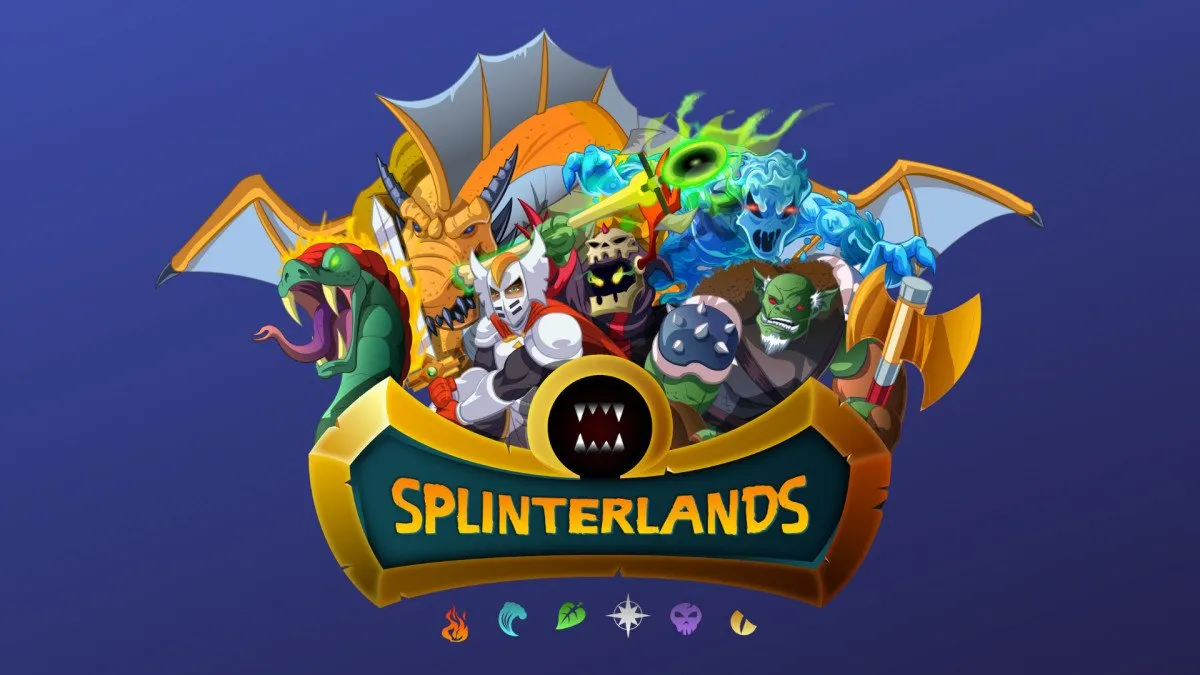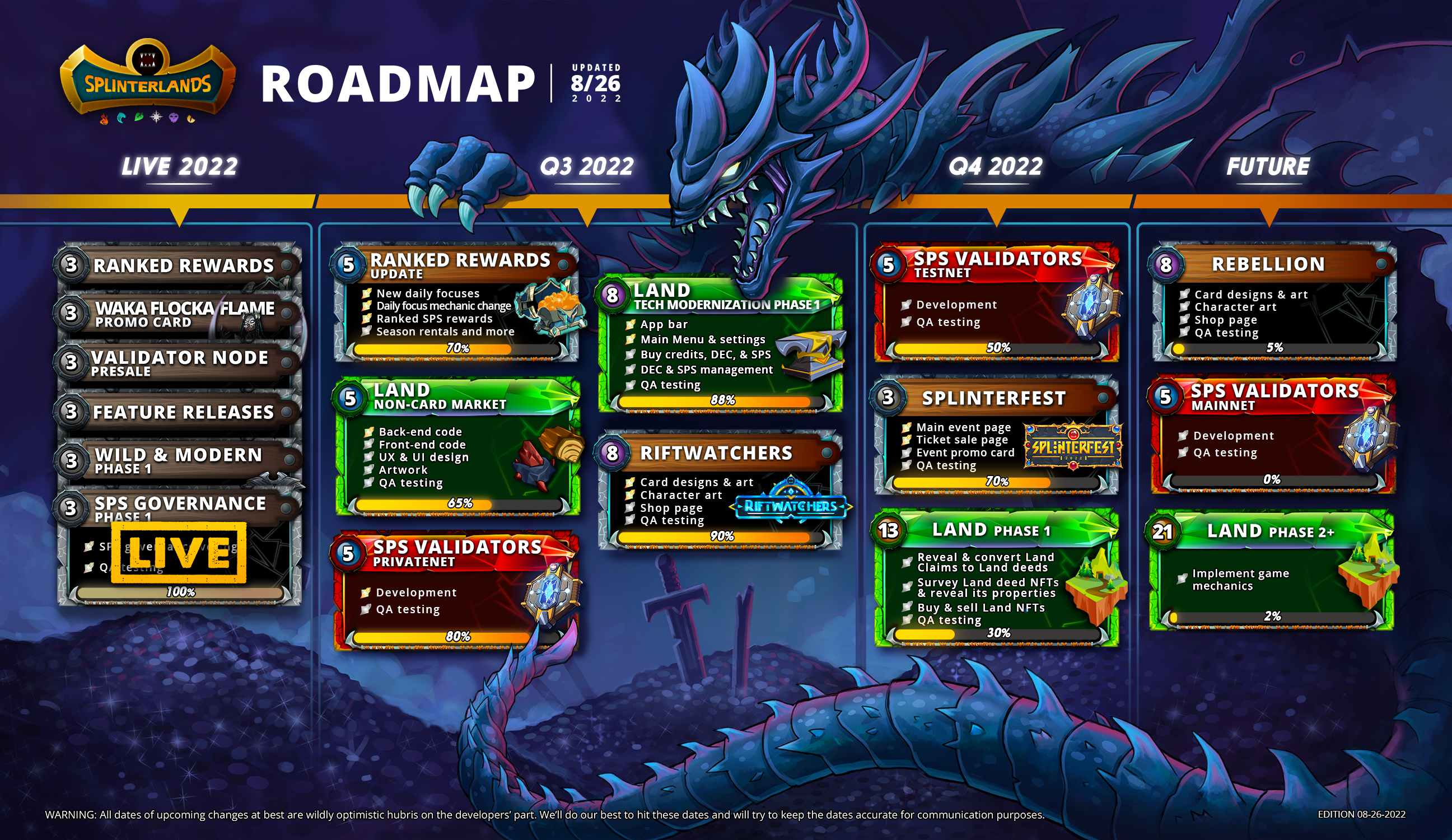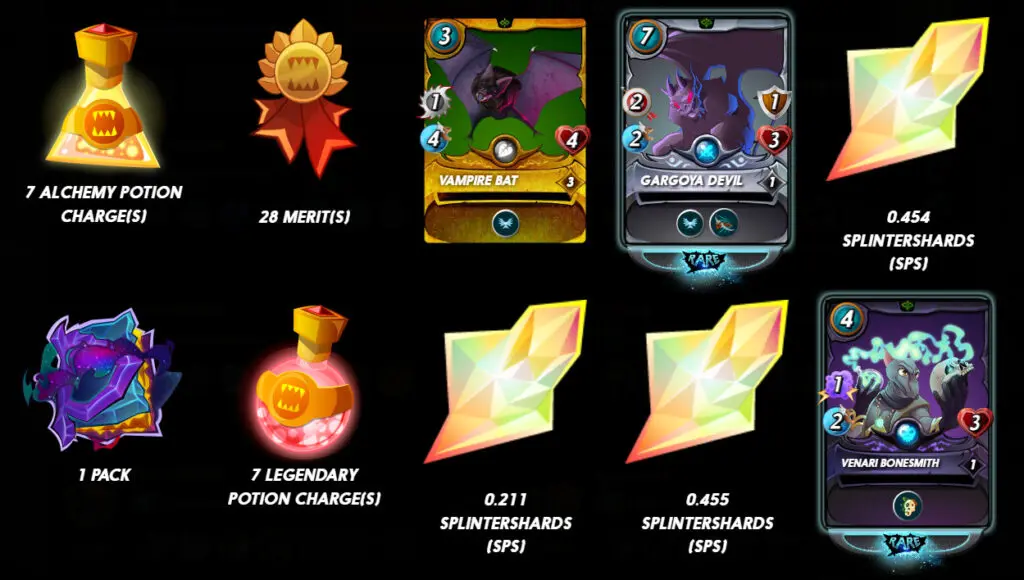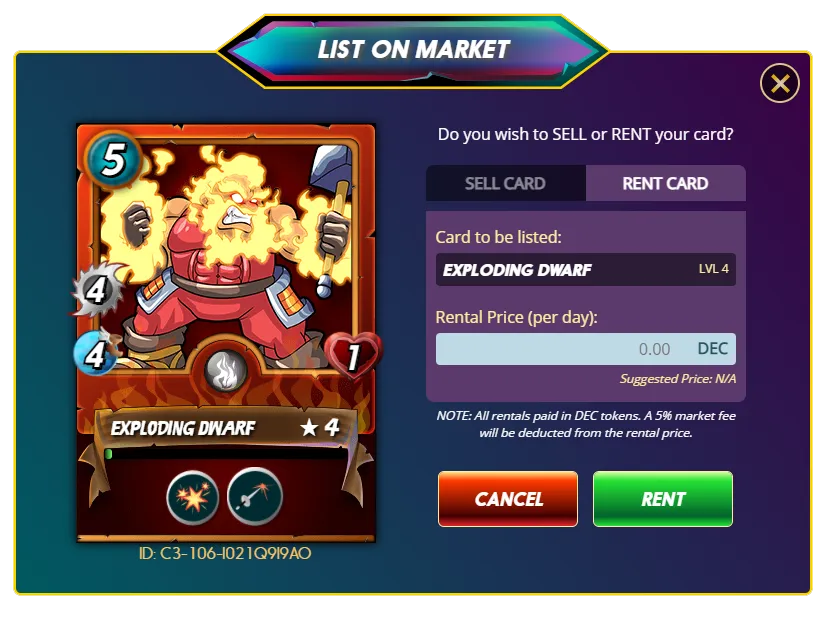Gear up crypto gamers, Splinterlands summons you to a world of powerful magic cards and epic battles! Master powerful spells, trade rare cards, and outwit opponents in fast-paced duels. Earn real rewards as you climb the ranks in this leading blockchain game.
Ready your deck and prepare for adventure – a gripping guide to Splinterlands awaits!

What is Splinterlands?
As a pioneering blockchain trading card game, Splinterlands ingeniously fuses deck-building strategy with quick-fire battles. It stands apart as an NFT play-to-earn title, enabling players to profit from their gaming exploits.
Boasting the most active user base of any blockchain game in Q2 2022 according to DappRadar, Splinterlands clearly has wide appeal. Co-founded in 2018 by Matthew Rosen and Jesse Reich, the game empowers players to truly own their digital cards unlike traditional titles.
Though inspired by classics like Magic: The Gathering and Hearthstone, matches in Splinterlands unfold rapidly yet still demand shrewd tactics. NFT cards form the backbone of its play-to-earn mechanics, bringing true digital ownership to this innovative hybrid genre.
Roadmap
The Splinterlands roadmap outlines major features and updates planned for the popular blockchain trading card game.
-
Q1 2023:
- DEC batteries to store excess earnings from battles
- Season-long (3 month) card rentals on marketplace
- Group card editions by set for easier browsing
- SPS validator nodes live internally to test network governance
- SPS delegation staking rewards
-
Q2 2023:
- SPS delegation rental markets to earn yield
- Pre-bundled card packs on marketplace
- Replace CP requirements with SPS staking for ranked battles
- SPS governance enabling player proposals and voting
- SPS validator nodes on public testnet
-
Q3 2023:
- Land gameplay phase 2 introducing buildings, resources, crafting
- Rebellion card set with new mechanics
- SPS validators running fully on mainnet, securing network
-
Future:
- Alliance system for guilds
- Interactive land maps with building visuals
- Cosmetic skins to customize cards
- Ruleset variations such as 2vs2 battles
- Marketplace listings for bundled card packs
The Splinterlands Map
Splinterlands stands as a pillar of the blockchain gaming scene as one of its original success stories. After years of anticipation, the game’s highly-touted land dimension will finally become usable by players with the upcoming The Secret of Praetoria map expansion.
Land has proven a hot commodity in metaverse and web3 games, with Splinterlands’ claim token NFTs selling for staggering amounts despite mystery surrounding their utility. The expansion’s 150 player-owned regions containing resource-rich, variably rare plots promise to make ownership worthwhile.
With terrain types, buildings, resources, and more influencing value, Splinterlands’ land marks a complex expansion beyond its autobattler roots. Long-awaited, this foundationally important addition aims to propel Splinterlands back to prominence in web3 gaming.
Players can also look forward to engaging gameplay possibilities combining strategic card battles with deeply customizable land ownership.
Splinterlands NFT
Splinterlands grants players true ownership of the NFT cards that are core to its gameplay. Cards can be used in the Splinterlands challenges, battles, traded freely, combined to level up, or burned for in-game currency. With complete control, players can enjoy cards as game assets or collectibles.
The 500+ cards span common to legendary rarity levels and seven elemental types called Splinters, each with unique stats. A $10 starter pack provides initial cards, while daily quests and contests offer further earning opportunities.
However, Splinterlands’ official marketplace is the primary source for obtaining new cards. Here players can browse listings and filter by attributes like price, rarity, Splinter, and more. The marketplace enables targeted acquisition to enhance your collection and create optimal decks. Additionally, cards can be bought and sold through secondary NFT marketplaces, leveraging Splinterlands’ interoperability.
Splinterlands grants true ownership through NFTs provides engaging gameplay and collecting while retaining player value and control.
Splinterlands Token (SPS)
Splintershards (SPS) serves as the main form of payment and governance token in the card trading game Splinterlands. As a cryptocurrency token, SPS aims to provide decision-making control and influence to stakeholders, asset owners, and the player base.
With a circulating supply of 389 million out of a maximum 3 billion, SPS is currently trading at $0.13. Most tokens are staked. The price of SPS has proven extremely volatile, hitting all-time highs of $1 on three separate occasions in 2021 before crashing 80% to $0.20. While near its record lows, SPS has recovered from previous major declines, suggesting potential for further price rebounds.
For investors focused on potential profits rather than gameplay, SPS’ performance relative to gaming NFTs will be of interest. With governance and payment utility within an active blockchain game, SPS offers speculative upside but its erratic swings make investing riskier than holding Splinterlands gaming NFTs directly. Nonetheless, those looking to capitalize on volatility may find opportunity in SPS.


Is Splinterlands Free to Play?
Splinterlands offers free basic access but to unlock play-to-earn features, tournaments, guilds, and more, players must purchase a Summoner’s Spellbook starter pack for $10. This nominal one-time purchase grants full functionality like the 3,000 credits to buy or rent cards from the outset.
How to Play Splinterlands?
Splinterlands accommodates mobile play for on-the-go dueling, with native apps available on both Android and iOS. Desktop access is also offered, providing players platform flexibility. By minimizing barriers to entry while still incentivizing investment through the Spellbook, Splinterlands makes it simple for users to start playing and earning on their preferred device.
Getting Started
- Purchase a Summoner’s Spellbook for $10 to unlock the full game and earning potential. This unlocks rewards and access to rankings.
- Complete the in-game tutorial to learn the basics of battles, mana limits, and card abilities.
- You receive a starter set of basic summoners and monsters to use for free. Moreover, experiment with different combinations to learn what works.
- Create a Hive account if you don’t have one already. This is needed to play Splinterlands. The Hive Keychain app handles logging in and transactions.
Earning Rewards
- Winning battles earns you Dark Energy Crystals (DEC), Splintershards (SPS) tokens, ranking points, reward cards, and chests containing more rewards.
- Daily quests provide additional way to earn rewards.
- At the end of each season, ranking points determine how many reward chests you receive. Chests can contain cards, DEC, SPS tokens, and potions.
- The top ranked players in each tier also receive bonus SPS rewards.
- Staking SPS tokens and owning Splinterlands licenses earns daily VOUCHER airdrops.


Getting Stronger
- Level up duplicate cards by combining them together. This powers up your cards with new abilities and higher stats.
- Rent higher level summoners and cards to boost your deck strength. Focus on a few summoners you like.
- Sell or rent away cards you don’t use often. Use the profits to upgrade cards you do use.
- Check opponent’s past battles to counter their playstyle and card choices.
- Don’t just use the strongest cards. Experiment to find synergies and combos. Add healers and support monsters.
- Play steady matches daily rather than marathon play sessions. This optimizes your capture rate for maximum earnings.
Advancing Ranks
- Bronze ranks don’t provide meaningful rewards. Focus on reaching Silver and higher.
- Battles get harder at higher ranks with tougher opponents and special rules.
- Carefully upgrade your summoners first, as their level limits the cards you can use.
- Rent better cards temporarily as needed to help advance ranks until you can afford upgrades.
How to Earn in Splinterlands?
Ranked Battles
Ranked Battles are the primary way to earn rewards in Splinterlands. By changing the battle type to “Ranked” on the Battle page, you can participate in ranked PvP matches. Once you reach Bronze II rank, you will start earning rewards of SPS tokens and R-shares for every ranked match you win. The amount you earn depends on your rank (higher ranks earn more), your capture rate (higher is better), and current market conditions influencing token value. Importantly, playtime does not affect earnings, so there is equal opportunity for all players regardless of how much they play.
Loot Chests
Another way to earn is through random Loot Chests containing cards, currency like DEC, consumable items, and resources. You can earn chests by completing daily quests, with the number of chests based on your R-shares earned from ranked wins. More chests are also granted at the end of ~2 week seasons based on which League you finish in, up to a maximum of 150 chests per season.
Splinterlands Tournaments
Entering in-game Tournaments hosted by Splinterlands and other players allows you to potentially win prizes. There is a wide variety of tournament types with different rules, entry fees, and prize pools. The main structures are Anytime, where you can play your match anytime in a 24 hour window, and Single Elimination, which has a set start time requiring you to be online.
Leaderboards
For top-ranked players, Leaderboards for the Modern and Wild formats offer another earnings avenue through DEC token rewards. At the end of each season, a total of 3,622,000 DEC is distributed based on placing, split across the 5 Leagues.
Earning Via NFTs
Trading Cards: Experienced players can also profit by buying and selling cards in the marketplace, similar to day trading stocks. Understanding valuations and marketplace trends is key to effectively buying low and selling high.


Renting Cards: Renting out your unused cards provides easy passive income, thanks to the built-in rental platform. Simply list a card, set rental terms, and get paid over time. You can cancel rentals anytime to get cards back if needed. This also allows monetization without having to sell cards.
Staking SPS: Lastly, staking your SPS tokens earns yield rewards while also granting governance rights. You can stake on yourself or delegate staking to other players for flexibility.
All investment/financial opinions expressed by NFTevening.com are not recommendations.
This article is educational material.
As always, make your own research prior to making any kind of investment.






